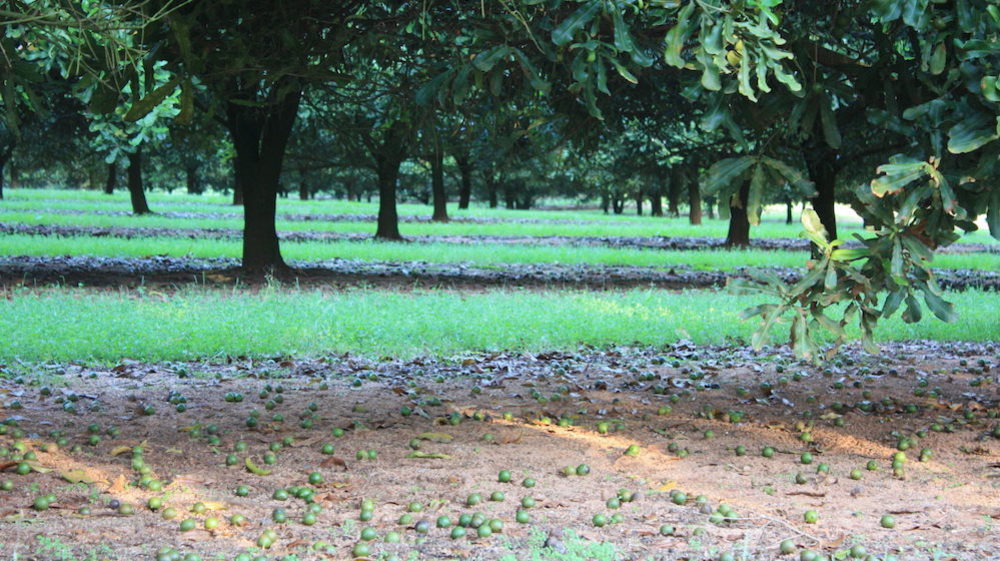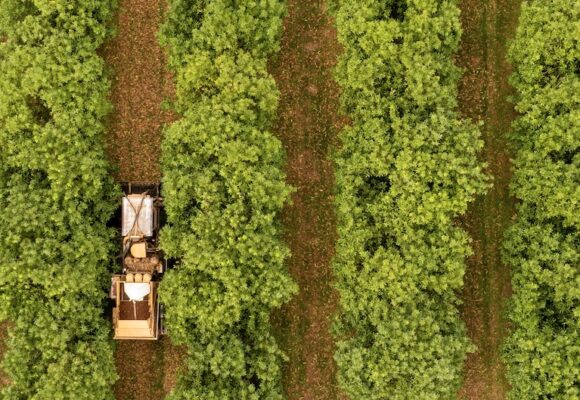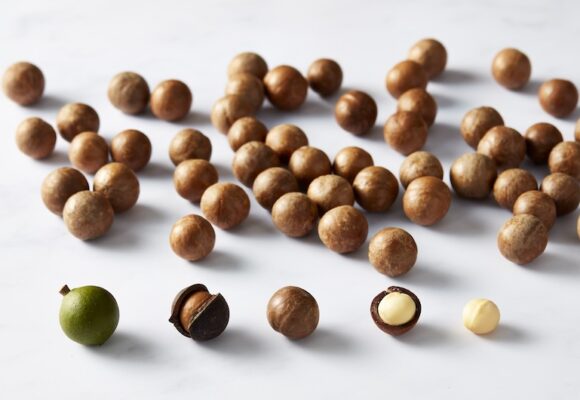The 2018 Australian Macadamia industry conference has just concluded for another two years. There was excellent attendance and a vibrant buzz as industry representatives from across the supply chain gathered to connect, share and learn on Queensland’s Gold Coast.

Australia’s macadamia industry is at a pivotal point as production rises from both our own crop, and those of other origins. As the world leader in production and marketing of our product, it’s a dynamic and opportunity-laden time.
This year’s conference showed the scale of innovative thinking in our industry has never been more impressive. Productivity and efficiency driven by technology are poised to dominate our future, with this investment set to deliver more consistent, high quality and reliable supply, and positioning us to capitalise on the opportunities that rising global production will bring.
Here’s a look at some of the highlights from our industry’s premier event.
Farms of the future
There’s substantial development occurring in the on-farm technology space. As industry consultant Dr Chris Searle said, “We’re on the edge of a technological revolution in horticulture and we need to be constructing orchards for the future, not just today. Automation and precision agriculture can give us the edge, but we need to be early adopters to stay ahead of the game.”

Macadamia Productivity Agronomist Dan Manson emphasised the importance of real data.
“Technology can now directly monitor trees and watch them responding to the environment in real time,” he said. “This feedback can then be used to better manipulate the environment and release any stress points the trees are showing.”
Tree water use and stress are two of the most powerful variables technology can measure in an orchard, with water being the primary driver of growth and productivity. Dan illustrated the use of sap flow sensors and psychrometers as two tools that can help determine if a tree is going into water stress before you can see it. This early warning can then be used to minimise premature nut drop and maximise productivity.
Tree shakers are another technological advancement that is helping extract a greater yield from every tree. “Trees have nuts sitting them that haven’t dropped,” explained Dan. “Shakers can extract an extra 1-2kg of nuts per tree, delivering extra return, and buying valuable time to reset the orchard for the next season.”
Hitting the innovation sweet spot
Australian Macadamias Market Development Manager Lynne Ziehlke explained the importance of innovation from a product development perspective, and how driving this is helping to secure our industry’s future.
“There’s a big opportunity in the ingredient space as macadamias are currently under-utilised globally in product categories such as cereals, confectionery and ice cream,” she said.

The Innovation Initiative, the cornerstone of our industry’s international marketing strategy, is helping food manufacturers to discover the unique role macadamias can play in product innovation.
“We have conducted a lot of research in multiple markets to understand where macadamias fit, and as a result, we know they’re a perfect product for innovation,” said Lynne. “All nuts are a product for today’s consumer, but our research has told us that macadamias add extra value and remove barriers to purchase. They elevate products and brands in the food industry in a way other nuts can’t.
“In the bakery category they help products compete in the premium space, while in snacks it takes just a few macadamias to make any snack product more indulgent. They deliver a unique eating experience in terms of bite, mouthfeel and taste and are great flavour carriers. They allow for a premium price point, and are ideally suited to the growing emotional snacking space.”
The research insights were supported by Kinga Wojciechowski, winner of the first Macadamia Innovation Challenge. “Macadamias are quite complex in flavour. Their nutty and buttery flavour works so well with other flavours. This is really important across product categories, but also in terms of global food innovation, as they pair well with the local food flavours of many different markets,” she said.
A sustainable future
The Australian macadamia industry has a history of embracing biological control on-farm. For example, many growers use the Trichogramma wasp to help contain loss to nut borer, while native barn owls are used to control rodents.
The past 20 years has seen resistance and emergence of new pests, greater scrutiny of crop protection methods, and consumers becoming more discerning in terms of how their food is produced. Entomologist Dr Paul Horne explained how biological and cultural control measures as part of Integrated Pest Management (IPM) are playing an increasing role in the protection of many crops.
Our industry has made considerable progress using IPM. For example, researchers, consultants, processors and growers successfully collaborated to develop natural techniques in the battle against the Macadamia Seed Weevil. This saw the adoption of a new management protocol that included out of season flowering, post-harvest clean-up and monitoring of larval stage emergence.
Mark Hickey from the Department of Primary Industries says IPM is a journey not a destination. “It’s as much about people as it is about the pest,” he said. “We need to continue testing and searching for new biological options, and be willing to adopt a holistic approach.”
Coupled with this was advice from Dr John Grant and Alan Coates on maintaining healthy soil on the orchard floor. “Healthy soil provides healthy crops, increased productivity, a healthy environment and more resilient trees,” they said. “If we’re serious about sustainable macadamia growing, we can’t let our soils deteriorate or erode. For a soil to be healthy and structurally sound, we have to maintain its physical and biological properties.”

Meanwhile the Macadamia Conservation Trust (MCT) continues to carry out vital work for our industry’s future by locating and preserving wild macadamia trees.
“Wild macadamias are a major competitive advantage for the Australian industry,” explained MCT’s Denise Bond. “They’re a treasure trove of genetic diversity and a living gene bank. MCT is running a Wild Macadamia Hunt to track down old wild macadamia trees in Brisbane before they’re lost forever. We’re also planning the largest arboretum of wild macadamias in the world.”
Taking quality to new heights
With consumer expectations at an all-time high, it’s never been more important to keep our quality game strong. Australian Macadamias Industry Development Manager Leoni Kojetin emphasised that this only happens when it starts on farm.
“We have a strong foothold in several markets, but we will only maintain this if we continue to meet quality expectations,” she cautioned. “We are moving into a space where we are playing in big global production. We need to produce the best macadamias the world has seen.”
“It’s the collective management of a host of elements that will ensure we achieve excellent kernel recovery and quality – varieties, environment, nutrition and soil health, pest and disease pressure, irrigation, and pollination,” she said.
Leoni believe harvest efficiency improvements will deliver rapid quality gains. “Getting a harvest from farm to processor as quickly as possible is really important. We are currently above other origins in terms of average saleable kernel recovery, but we can do better.”
Looking beyond our industry
The conference provided an ideal opportunity to draw on horticultural knowledge beyond our own industry. Andrew Bulmer, Managing Director of Bulmer Farms, one of Australia’s largest salad producers, and 2017 ABC Rural Farmer of the Year, shared his story and lessons learned.
After many years of enduring severe weather events, Andrew decided to try a different approach. “Instead of being a victim, we decided to control our own destiny as much as we could, by applying world’s best practice.”
This decision had Andrew inviting himself to as many farms and agri-businesses around the world to see what they were doing. He returned with new crops, equipment and technology that resulted in an astonishing 600% growth in his baby salad business in 18 months, and a business that now turns over AUD $25 million per annum.
Andrew is optimistic about the future of Australian horticulture. “Automation is here, and innovation will be a constant theme. It’s an exciting time to be a producer with things like infra-red technology, on-farm weather stations, fully automated irrigation systems, and driverless tractors all on the horizon.”
Opportunities and risks in China
There’s no denying the importance of China to our industry, both as a market, and as a fellow producer. The conference discussed the opportunity China presents, and reflect on learnings from the recent International Macadamia Symposium and production tour in China.
Rabobank’s Tim Hunt unpacked the escalating tensions between the US and China, and what a trade war could mean for Australia’s macadamia industry.
The Australia-China Free Trade Agreement that has seen tariffs substantially reduced since 2015 and set to hit zero next year. China’s income growth has seen rapid growth in retail sales.
However Tim explained it’s not just about market growth, but also our access to it.
“China values Australia’s safe supply chains and the story behind our food in a way that Europe and the US just don’t have,” he said. “We’re also seeing rapid development of internet sales of food products into China through platforms like Alibaba. This combination that has seen sales in China take off in terms of volume and value.”
So what would a significant US-China trade war mean for us? In the short term, currency fluctuations are making our product look more attractive compared to that of the US, and we are more competitive in terms of exports to China than the US.
However the long term is not without some level of risk. A trade war would see the economies of both the US and China contract, prompting reduced spending across the board. It’s a situation that should be monitored closely, while maintaining some market diversity and developing contingency plans.
In terms of production, Leonie Kojetin, Lynne Ziehlke and Jolyon Burnett shared their observations from their recent time in China, remarking on the huge progress made by its macadamia industry over the past six years.

China’s macadamia production is centred in four provinces – Guangxi, Yunnan, Guizhou and Guangdong. There’s reportedly 192,500 hectares under planting, with 57 million trees. The industry has developed as a poverty alleviation scheme, with heavy government subsidisation, low technology use, and high labour. Crops are harvested by hand, and post-harvest facilities are improving.
Lynne Ziehlke provided an overview of macadamia marketing in China, reporting extremely high use of digital and faster growth of online business than anywhere else in the world. “New retail combines online and offline,” she said. “Brands are realising they need to provide both experiences to consumers.”
The big six snack brands in China have built a business around tree nuts. “Packaging, branding and marketing is very sophisticated,” said Lynne. “Because they’re operating online, it’s all about big data – they know their consumers very well.”
Jolyon Burnett concluded by saying it’s still early days in China. “The planting is there, but the production is still a long way off. There will be some speed bumps along the way, but the positivity and vision of the Chinese is impressive,” he said. “The respect and value that is attached to the macadamia industry there is exemplary.”
The conference was hosted by the Australian Macadamias Society and supported by our platinum partner Hort Innovation.


